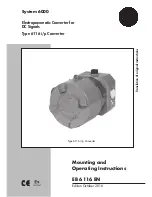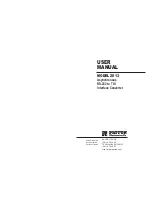
3
SAFETY AND OPERATION OF THE BLOCK SPLITTER
DESCRIPTION
The FBS40M block splitter is designed to cut materials such as paving slabs, paving blocks
and building blocks etc. with parallel faces. The maximum depth of slab that may be cut is
210mm, the minimum is 45mm and the maximum width is 400mm.
SAFETY
Ensure splitter is standing on a firm level surface.
Wear eye protection, gloves and safety footwear.
Do not allow hands or feet to be between the blades when carrying out any blade
adjustments.
Ensure the Handle is in its fully upright position between cuts.
Never leave the machine unattended with the Handle in the upright position. The
Handle should be left in its lowered position.
When moving the machine ensure there is no material on the table which will slide
off when the machine is tilted.
Never use additional extension bars other than the one provided with the machine.
Take care when adjusting the cutting table – there is a risk of trapping fingers.
CAUTION
Avoid warped or ‘green’ blocks and slabs. These will break prematurely and not
where required. All slabs must have flat parallel faces; riven slabs are unsuitable for
splitting.
Check sharpness of blades regularly. Cut only with blades in good condition. Replace
if worn or damaged.
Do not attempt to cut material of a size outside the range of the splitter.
It is not possible to be specific with regard to the types of materials that are suitable for
splitting and that are unsuitable. Generally a material that splits quickly, easily and cleanly
with a sharp crack-like noise is suitable; a material that splits irregularly and requires a high
level of effort is unsuitable. If the material appears to crush or crumble during the cutting
action then this may indicate that the material is too soft and unsuitable. Repeated
attempts to cut this material will damage the machine and this will not be covered by
warranty.
ADJUSTMENTS
In order to obtain a clean cut (break) it is essential that the upper blade is parallel to the
surface of the material to be cut. To ensure this, place the material to be cut across the lower
blade, pull the handle downwards so that the top blade just contacts the material. If the top
blade is only in contact at one end of the material, slacken the hand screw and continue to
operate the handle to create a slight pressure. This will automatically adjust the top blade so
that it is parallel to the material surface. Check that the blade contacts all the way along and
then retighten the hand screw.



























